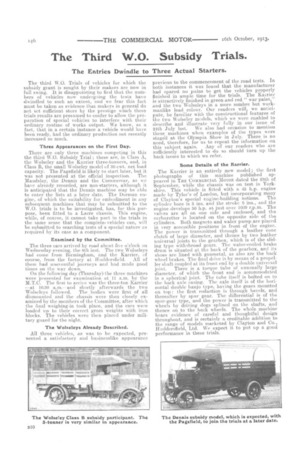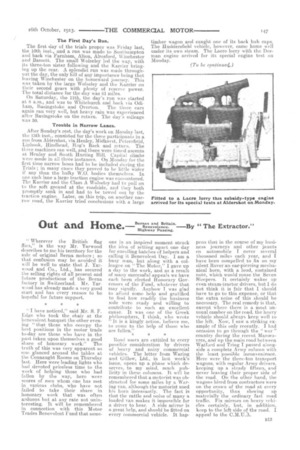The Third W.O. Subsidy Trials.
Page 6

Page 7

If you've noticed an error in this article please click here to report it so we can fix it.
The Entries Dwindle to Three Actual Starters.
The third W.O. Trials of vehicles for which the subsidy grant is sought by their makers are now in full swing. It is disappointing to find that the numbers of vehicles now undergoing the tests have dwindled to such an extent, and we fear this fact must be taken as evidence that makers in general do not set sufficient store by the prestige which these trials results are presumed to confer to allow the preparation of special vehicles to interfere with their ordinary routine of works output. We know, as a fact, that in a certain instance a vehicle would have been ready, had the ordinary production not recently increased so much.
Three Appearances on the First Day.
There are only three machines competing in this the third W.O. Subsidy Trial ; these are, in Class A, the Wolseley and the Karrier three-tontiers, and, in Class B, the small Wolseley model of 30-cwt. net load capacity. The Pagefield is likely to start later, but it
was not presented at the official inspection. The Mandslay, the Dennis and the Cornmercar, as we have already recorded, are non-starters, although it is anticipated that the Dennis machine may be able to enter the lists at a later date. The Dorman engine, of which the suitability for embodiment in any subsequent machines that may be submitted to the W.O. trials is to be investigated, has, for this purpose, been fitted to a Lacre chassis. This engine, while, of course, it cannot take part in the trials in the same sense that the completei vehicles can, will be submitted to searching tests of a special nature as required by its case as a component.
Examined by the Committee.
The three cars arrived by road about five o'clock on Wednesday evening, the 8th inst. The two Wolseleys had come from Birmingham, and the Karrier, of course, from the factory at Huddersfield. All of them had uneventful journeys and had made good times on the way down.
On the following day (Thursday) the three machines were presented for examination at 11 a.m, by the M.T.C. The first to arrive was the three-ton Karrier —at 10.30 a.m.—and shortly afterwards the two Wolseleys followed. The bodies were first of all dismounted and the chassis were then closely examined by the members of the Committee, after which the final weighing-in took place, and the cars were loaded up to their correct gross weights with iron blocks. The. vehicles were then placed under military guard for the night.
The Wolseleys Already Described.
All three vehicles, as was to be expected, presented a satisfactory and businesslike appearance
previous to the commencement of the road tests. In both instances it was found that the manufacturer had spared no pains to get the vehicles properly finished in ample time for the trials. The Karrier is attractively finished in green and red " war paint," and the two Wolseleys in a more sombre but workmanlike lead colour. Our readers will we anticipate, be familiar with the constructional features of the two Wolseley models, which we were enabled to describe and illustrate very fully in our issue of 24th July last. We also had occasion to mention these machines when examples of the types were staged at the Olympia Show in July. There is no need, therefore, for us to repeat the information on this subject again. Any of our readers who are sufficiently interested to do so should turn up the back issues to which we refer.
Some Details of the Karrier.
The Karrier is an entirely new model; the first photographs of this machine published appeared in THE CommEaefAn MOTOR dated the 25th of September, while the chassis was on test in Yorkshire. This vehicle is fitted with a 45 lip. engine made by Tylor's of London, but incorporating many
of Clayton's special engine-building notions. The cylinder bore is 5 ins, and the stroke 6 ins., and the engine develops 50 h.p. at just over 1000 r.p.m. The valves are all on one side and enclosed, and the carburetter is located on the opposite side of the cylinders. Both magneto and water pump are placed in very accessible positions in front of the engine. The power is transmitted through a leather cone clutch of large diameter, and thence by two leather universal joints to the gearbox, which is of the sliding type with ibroa,d gears. The water-cooled brake drum is situated at the back of the gearbox, and its shoes are lined with gunmetal, as also are the back wheel brakes. The final cb ivc is by means of a propeller shaft coupled at its front end by a double universal joint. There is a torque tube of unusually large diameter, of which the front end is accommodated in a spherical joint. The tube itself is bolted on to the back axle casing. The axle itself is of the horizontal double banjo type, having the gears mounted on top : the first reduction is through bevels, and thereafter by spur gear. The differential is of the spur-gear type, and the power is transmitted to the wheels by driving dogs spin-led on the shafts, and thence on to the hack wheels. The whole machine bears evidence of careful and thoughtful design throughout, and is certainly a creditable addition to the range of models marketed by Clayton and Co., Huddersfield, Ltd. We expect it to put up a good performance in these trials. The First Day's Run.
The first day of the trials proper was Friday last, the 10th inst., and a run was made to Southampton and back via Farnham, Alton, Alresford, Winchester and Bassett. The small Wolseley loci the way, with its three-ton sister following and the Ran-ier bringing up the rear. A splendid run was made throughout the day, the only hill of any importance being that leaving Winchester on the homeward journey. This was taken by the large Wolseley and the Karrier on their second gears with plenty of reserve power. The total distance for the day was 81 miles. On Saturday, the 11th, the day's run was started at 8 a.m., and was to Whitchurch and back via 0thham, Basingstoke and Overton. The three cars again ran very well, but heavy rain was experienced after Basingstoke on the return. The day's mileage was 59.
Trouble in Narrow Lanes.
After Sunday's rest, the day's work on Monday last, the 13th inst., consisted for the three participants in a run from Aldershot, via Henley, Midhurst, Petersfield, Liphook, Hindhead, Hog's Back and return. The three machines ran well, and there were timed ascents at Henley and South Harting Hill. Capital climbs were made in all three instances. On Monday for the first time narrow lanes had to be included during the Trials ; in many cases they proved to be little wider if any than the bulky W.O. bodies themselves. In one such lane a large traction engine was encountered. The Karrier and the Class A Wolseley had to pull on to the soft ground at the roadside, and they both promptly sank in and had to be towed out by the traction engine. Later, on this trip, on another narrow road, the Karrier tried -conclusions with a large timber wagon and caught one of its back hub caps. The Huddersfield vehicle, however, came home well under its own steam. The Lacre lorry with the Dorman engine arrived for its special engine test on 'Monday.




















